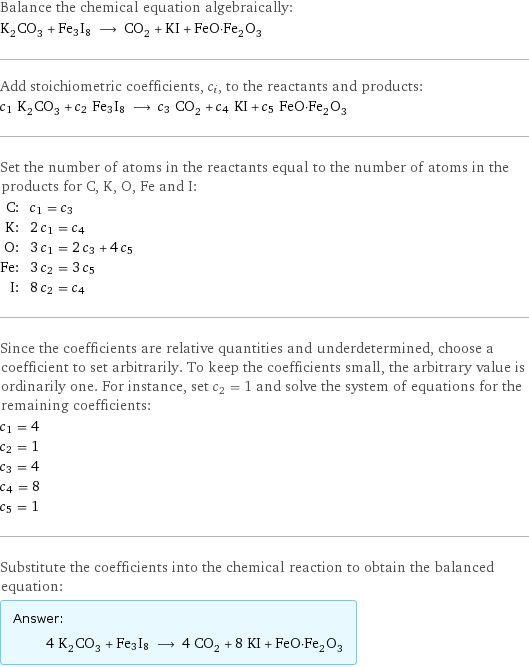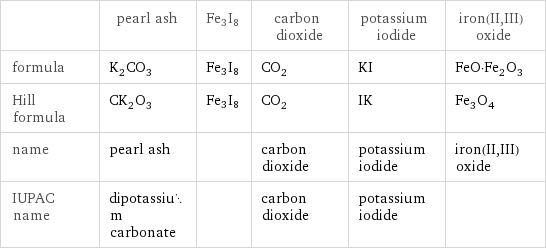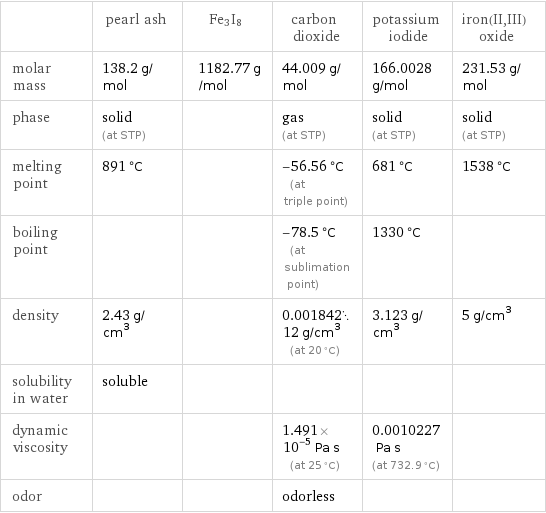Input interpretation

K_2CO_3 pearl ash + Fe3I8 ⟶ CO_2 carbon dioxide + KI potassium iodide + FeO·Fe_2O_3 iron(II, III) oxide
Balanced equation

Balance the chemical equation algebraically: K_2CO_3 + Fe3I8 ⟶ CO_2 + KI + FeO·Fe_2O_3 Add stoichiometric coefficients, c_i, to the reactants and products: c_1 K_2CO_3 + c_2 Fe3I8 ⟶ c_3 CO_2 + c_4 KI + c_5 FeO·Fe_2O_3 Set the number of atoms in the reactants equal to the number of atoms in the products for C, K, O, Fe and I: C: | c_1 = c_3 K: | 2 c_1 = c_4 O: | 3 c_1 = 2 c_3 + 4 c_5 Fe: | 3 c_2 = 3 c_5 I: | 8 c_2 = c_4 Since the coefficients are relative quantities and underdetermined, choose a coefficient to set arbitrarily. To keep the coefficients small, the arbitrary value is ordinarily one. For instance, set c_2 = 1 and solve the system of equations for the remaining coefficients: c_1 = 4 c_2 = 1 c_3 = 4 c_4 = 8 c_5 = 1 Substitute the coefficients into the chemical reaction to obtain the balanced equation: Answer: | | 4 K_2CO_3 + Fe3I8 ⟶ 4 CO_2 + 8 KI + FeO·Fe_2O_3
Structures

+ Fe3I8 ⟶ + +
Names

pearl ash + Fe3I8 ⟶ carbon dioxide + potassium iodide + iron(II, III) oxide
Equilibrium constant
![Construct the equilibrium constant, K, expression for: K_2CO_3 + Fe3I8 ⟶ CO_2 + KI + FeO·Fe_2O_3 Plan: • Balance the chemical equation. • Determine the stoichiometric numbers. • Assemble the activity expression for each chemical species. • Use the activity expressions to build the equilibrium constant expression. Write the balanced chemical equation: 4 K_2CO_3 + Fe3I8 ⟶ 4 CO_2 + 8 KI + FeO·Fe_2O_3 Assign stoichiometric numbers, ν_i, using the stoichiometric coefficients, c_i, from the balanced chemical equation in the following manner: ν_i = -c_i for reactants and ν_i = c_i for products: chemical species | c_i | ν_i K_2CO_3 | 4 | -4 Fe3I8 | 1 | -1 CO_2 | 4 | 4 KI | 8 | 8 FeO·Fe_2O_3 | 1 | 1 Assemble the activity expressions accounting for the state of matter and ν_i: chemical species | c_i | ν_i | activity expression K_2CO_3 | 4 | -4 | ([K2CO3])^(-4) Fe3I8 | 1 | -1 | ([Fe3I8])^(-1) CO_2 | 4 | 4 | ([CO2])^4 KI | 8 | 8 | ([KI])^8 FeO·Fe_2O_3 | 1 | 1 | [FeO·Fe2O3] The equilibrium constant symbol in the concentration basis is: K_c Mulitply the activity expressions to arrive at the K_c expression: Answer: | | K_c = ([K2CO3])^(-4) ([Fe3I8])^(-1) ([CO2])^4 ([KI])^8 [FeO·Fe2O3] = (([CO2])^4 ([KI])^8 [FeO·Fe2O3])/(([K2CO3])^4 [Fe3I8])](../image_source/1f08c49ef84a62fd4c957d835648a4e8.png)
Construct the equilibrium constant, K, expression for: K_2CO_3 + Fe3I8 ⟶ CO_2 + KI + FeO·Fe_2O_3 Plan: • Balance the chemical equation. • Determine the stoichiometric numbers. • Assemble the activity expression for each chemical species. • Use the activity expressions to build the equilibrium constant expression. Write the balanced chemical equation: 4 K_2CO_3 + Fe3I8 ⟶ 4 CO_2 + 8 KI + FeO·Fe_2O_3 Assign stoichiometric numbers, ν_i, using the stoichiometric coefficients, c_i, from the balanced chemical equation in the following manner: ν_i = -c_i for reactants and ν_i = c_i for products: chemical species | c_i | ν_i K_2CO_3 | 4 | -4 Fe3I8 | 1 | -1 CO_2 | 4 | 4 KI | 8 | 8 FeO·Fe_2O_3 | 1 | 1 Assemble the activity expressions accounting for the state of matter and ν_i: chemical species | c_i | ν_i | activity expression K_2CO_3 | 4 | -4 | ([K2CO3])^(-4) Fe3I8 | 1 | -1 | ([Fe3I8])^(-1) CO_2 | 4 | 4 | ([CO2])^4 KI | 8 | 8 | ([KI])^8 FeO·Fe_2O_3 | 1 | 1 | [FeO·Fe2O3] The equilibrium constant symbol in the concentration basis is: K_c Mulitply the activity expressions to arrive at the K_c expression: Answer: | | K_c = ([K2CO3])^(-4) ([Fe3I8])^(-1) ([CO2])^4 ([KI])^8 [FeO·Fe2O3] = (([CO2])^4 ([KI])^8 [FeO·Fe2O3])/(([K2CO3])^4 [Fe3I8])
Rate of reaction
![Construct the rate of reaction expression for: K_2CO_3 + Fe3I8 ⟶ CO_2 + KI + FeO·Fe_2O_3 Plan: • Balance the chemical equation. • Determine the stoichiometric numbers. • Assemble the rate term for each chemical species. • Write the rate of reaction expression. Write the balanced chemical equation: 4 K_2CO_3 + Fe3I8 ⟶ 4 CO_2 + 8 KI + FeO·Fe_2O_3 Assign stoichiometric numbers, ν_i, using the stoichiometric coefficients, c_i, from the balanced chemical equation in the following manner: ν_i = -c_i for reactants and ν_i = c_i for products: chemical species | c_i | ν_i K_2CO_3 | 4 | -4 Fe3I8 | 1 | -1 CO_2 | 4 | 4 KI | 8 | 8 FeO·Fe_2O_3 | 1 | 1 The rate term for each chemical species, B_i, is 1/ν_i(Δ[B_i])/(Δt) where [B_i] is the amount concentration and t is time: chemical species | c_i | ν_i | rate term K_2CO_3 | 4 | -4 | -1/4 (Δ[K2CO3])/(Δt) Fe3I8 | 1 | -1 | -(Δ[Fe3I8])/(Δt) CO_2 | 4 | 4 | 1/4 (Δ[CO2])/(Δt) KI | 8 | 8 | 1/8 (Δ[KI])/(Δt) FeO·Fe_2O_3 | 1 | 1 | (Δ[FeO·Fe2O3])/(Δt) (for infinitesimal rate of change, replace Δ with d) Set the rate terms equal to each other to arrive at the rate expression: Answer: | | rate = -1/4 (Δ[K2CO3])/(Δt) = -(Δ[Fe3I8])/(Δt) = 1/4 (Δ[CO2])/(Δt) = 1/8 (Δ[KI])/(Δt) = (Δ[FeO·Fe2O3])/(Δt) (assuming constant volume and no accumulation of intermediates or side products)](../image_source/52716942b247ce8ea4eef1eb4bcfcba9.png)
Construct the rate of reaction expression for: K_2CO_3 + Fe3I8 ⟶ CO_2 + KI + FeO·Fe_2O_3 Plan: • Balance the chemical equation. • Determine the stoichiometric numbers. • Assemble the rate term for each chemical species. • Write the rate of reaction expression. Write the balanced chemical equation: 4 K_2CO_3 + Fe3I8 ⟶ 4 CO_2 + 8 KI + FeO·Fe_2O_3 Assign stoichiometric numbers, ν_i, using the stoichiometric coefficients, c_i, from the balanced chemical equation in the following manner: ν_i = -c_i for reactants and ν_i = c_i for products: chemical species | c_i | ν_i K_2CO_3 | 4 | -4 Fe3I8 | 1 | -1 CO_2 | 4 | 4 KI | 8 | 8 FeO·Fe_2O_3 | 1 | 1 The rate term for each chemical species, B_i, is 1/ν_i(Δ[B_i])/(Δt) where [B_i] is the amount concentration and t is time: chemical species | c_i | ν_i | rate term K_2CO_3 | 4 | -4 | -1/4 (Δ[K2CO3])/(Δt) Fe3I8 | 1 | -1 | -(Δ[Fe3I8])/(Δt) CO_2 | 4 | 4 | 1/4 (Δ[CO2])/(Δt) KI | 8 | 8 | 1/8 (Δ[KI])/(Δt) FeO·Fe_2O_3 | 1 | 1 | (Δ[FeO·Fe2O3])/(Δt) (for infinitesimal rate of change, replace Δ with d) Set the rate terms equal to each other to arrive at the rate expression: Answer: | | rate = -1/4 (Δ[K2CO3])/(Δt) = -(Δ[Fe3I8])/(Δt) = 1/4 (Δ[CO2])/(Δt) = 1/8 (Δ[KI])/(Δt) = (Δ[FeO·Fe2O3])/(Δt) (assuming constant volume and no accumulation of intermediates or side products)
Chemical names and formulas

| pearl ash | Fe3I8 | carbon dioxide | potassium iodide | iron(II, III) oxide formula | K_2CO_3 | Fe3I8 | CO_2 | KI | FeO·Fe_2O_3 Hill formula | CK_2O_3 | Fe3I8 | CO_2 | IK | Fe_3O_4 name | pearl ash | | carbon dioxide | potassium iodide | iron(II, III) oxide IUPAC name | dipotassium carbonate | | carbon dioxide | potassium iodide |
Substance properties

| pearl ash | Fe3I8 | carbon dioxide | potassium iodide | iron(II, III) oxide molar mass | 138.2 g/mol | 1182.77 g/mol | 44.009 g/mol | 166.0028 g/mol | 231.53 g/mol phase | solid (at STP) | | gas (at STP) | solid (at STP) | solid (at STP) melting point | 891 °C | | -56.56 °C (at triple point) | 681 °C | 1538 °C boiling point | | | -78.5 °C (at sublimation point) | 1330 °C | density | 2.43 g/cm^3 | | 0.00184212 g/cm^3 (at 20 °C) | 3.123 g/cm^3 | 5 g/cm^3 solubility in water | soluble | | | | dynamic viscosity | | | 1.491×10^-5 Pa s (at 25 °C) | 0.0010227 Pa s (at 732.9 °C) | odor | | | odorless | |
Units
